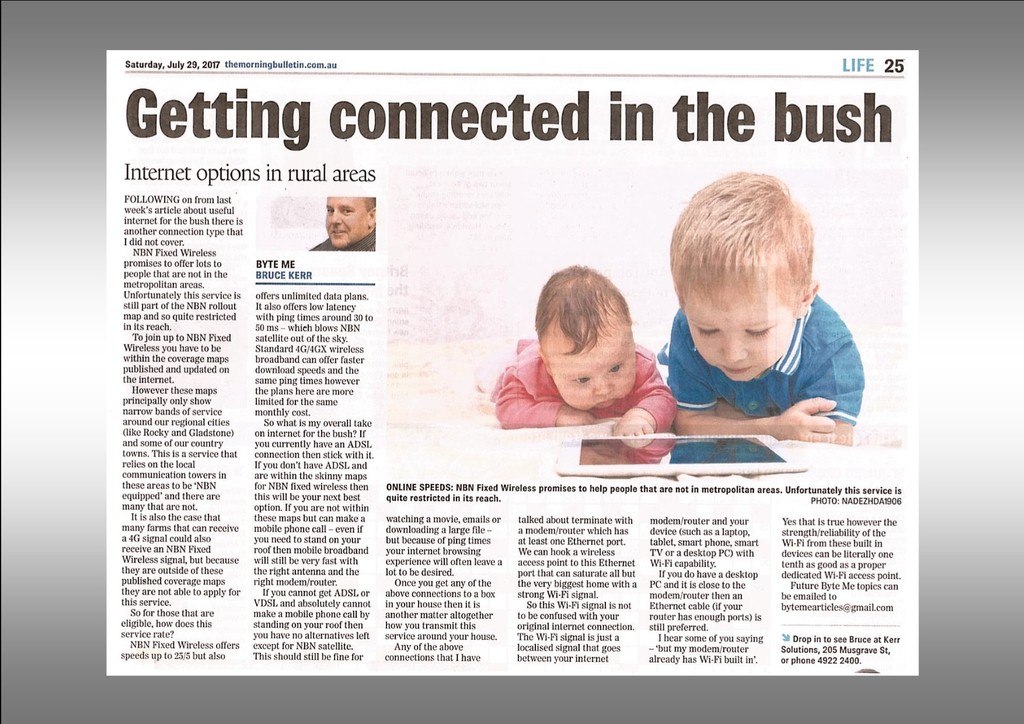29th July 2017
Getting Connected in the Bush
Following on from last weeks’ article about useful Internet for the Bush there is another connection type that I did not cover. Called NBN Fixed Wireless it promises to offer lots to people that are not in the metropolitan areas. Unfortunately this service is still part of the NBN rollout map and so it is quite restricted in its reach.
To join up to NBN Fixed Wireless you have to be within the coverage maps that are published and updated on the Internet. However these maps principally only show narrow bands of service around our regional cities (like Rocky & Gladstone) and some of our country towns. This is a service that relies on the local communication towers in these areas to be ‘NBN equipped’ and there are many that are not.
It is also the case that many farms that can receive a 4G signal could also receive an NBN Fixed Wireless signal, but because they are outside of these published coverage maps they are not able to apply for this service. So for those that are eligible, how does this service rate?

NBN Fixed Wireless offers speeds up to 25/5 but also offers unlimited data plans. It also offers low Latency with ping times around 30 to 50 ms – which blows NBN satellite out of the sky! Standard 4G / 4GX wireless broadband can offer faster download speeds and the same ping times however the plans here are more limited for the same monthly cost.
So what is my overall take on Internet for the Bush? If you currently have an ADSL connection then stick with it. If you don’t have ADSL and are within the skinny maps for NBN fixed wireless then this will be your next best option. If you are not within these maps but can make a mobile phone call – even if you need to stand on your roof then mobile broadband will still be very fast with the right antenna and the right modem/router (e.g. the ones that we sell and setup).
If you cannot get ADSL or VDSL and absolutely cannot make a mobile phone call by standing on your roof then you have no alternatives left except for NBN satellite. Keep in mind that this should still be fine for watching a movie, emails or downloading a large file – but because of ping times your Internet browsing experience will often leave a lot to be desired.
Once you get any of the above connections to a box in your house then it is another matter altogether how you transmit this service around your house. Any of the above connections that I have talked about terminate with a modem/router which has at least one Ethernet port. We can hook a wireless access point to this Ethernet port that can saturate all but the very biggest home with a strong Wi-Fi signal.
So this Wi-Fi signal is not to be confused with your original Internet connection. The Wi-Fi signal is just a localised (e.g. 100 meter range) signal that goes between your Internet modem/router and your end device such as a laptop, tablet, smart phone, smart TV or a desktop PC with Wi-Fi capability. If you do have a desktop PC and it is close to the modem/router then an Ethernet cable (if your router has enough ports) is still preferred.
I hear some or you saying – ‘but my modem/router already has Wi-Fi build in’. Yes that is true however the strength / reliability of the Wi-Fi from these built in devices can be literally one tenth as good as a proper dedicated Wi-Fi access point.
Future Byte Me topics can be emailed to [email protected] and Bruce is contactable at Kerr Solutions, 205 Musgrave Street or on 49 222 400.
For more advice and assistance from Kerr Solutions, like and follow us on Facebook
